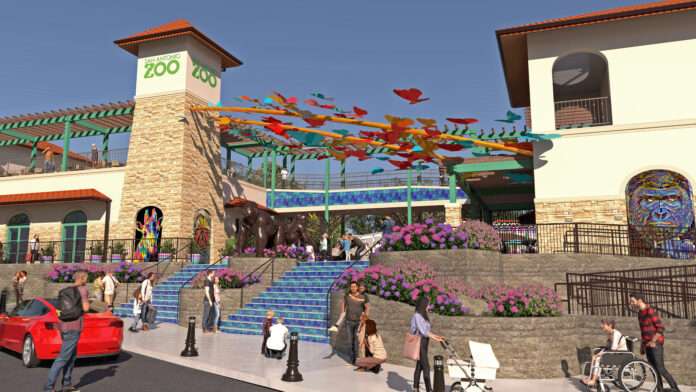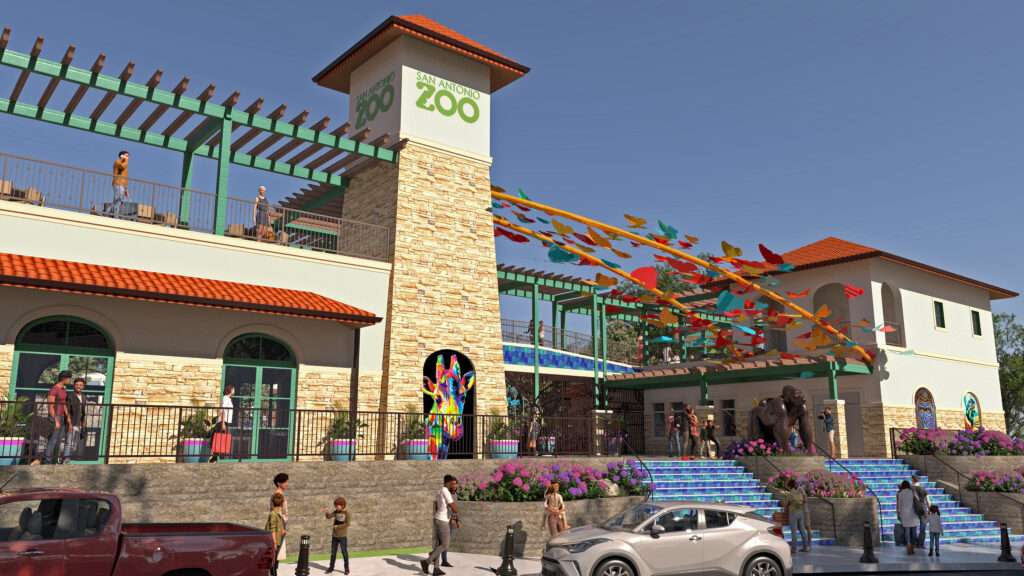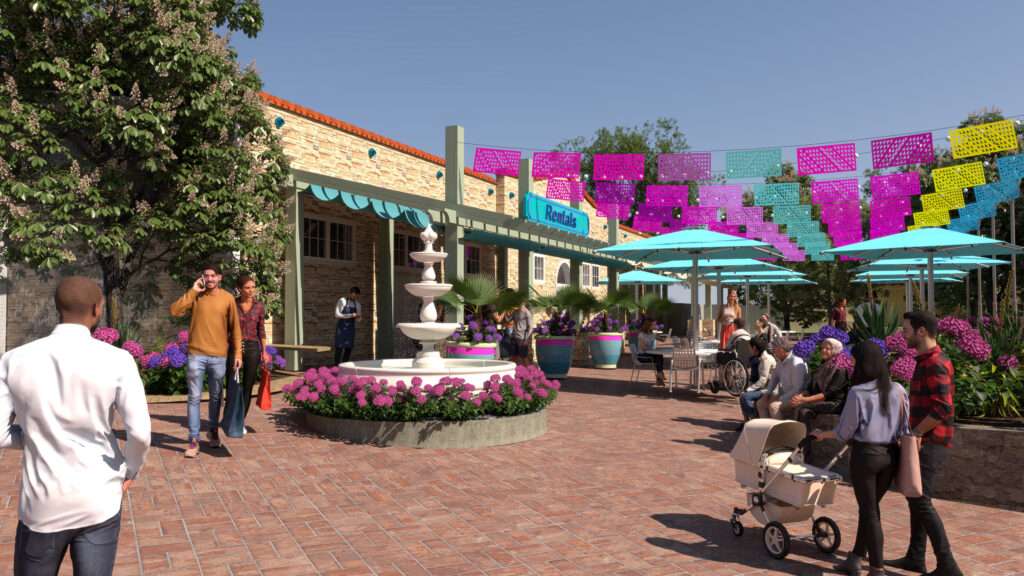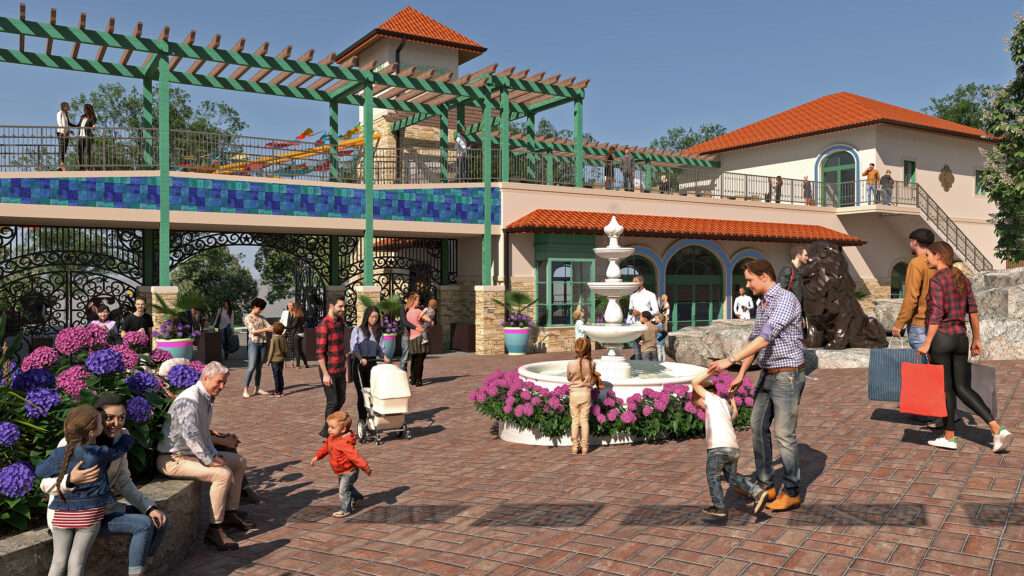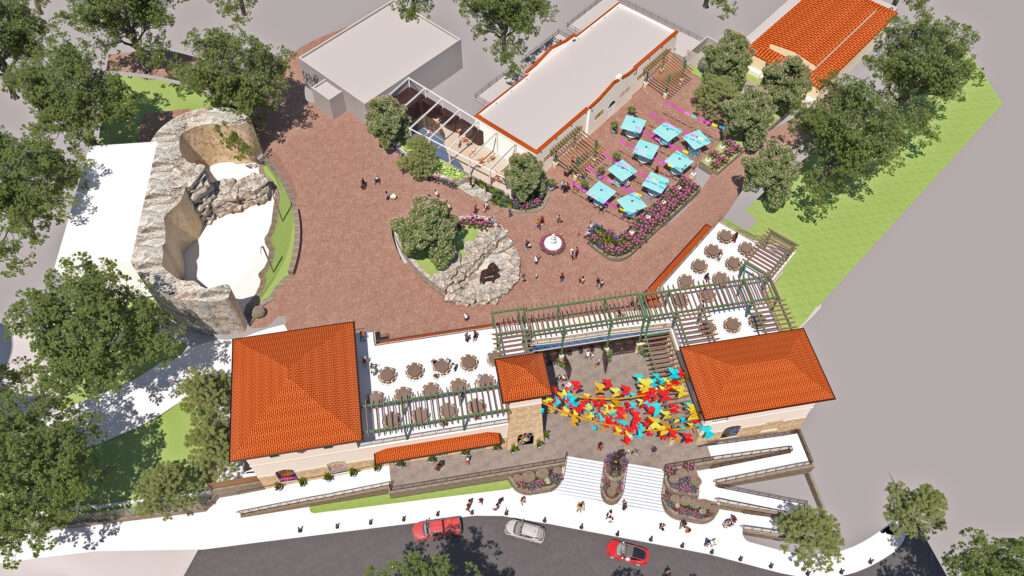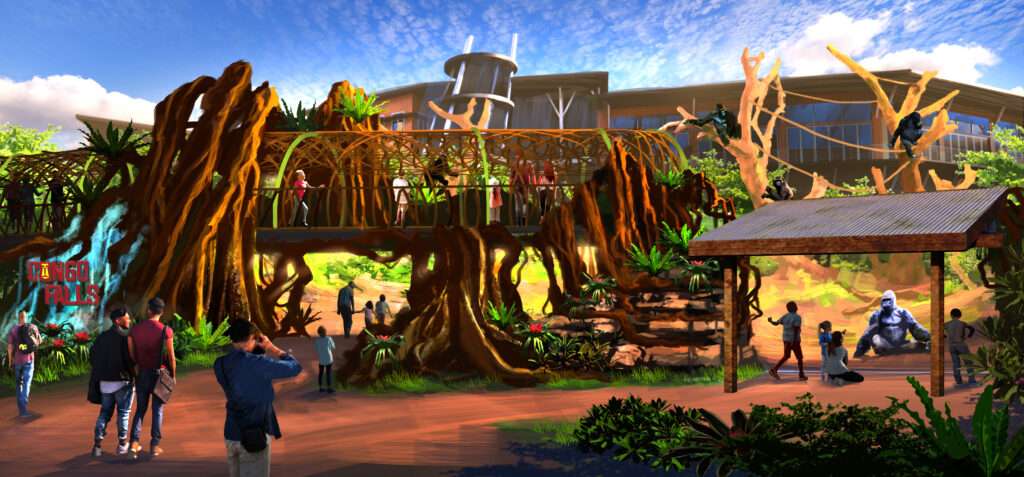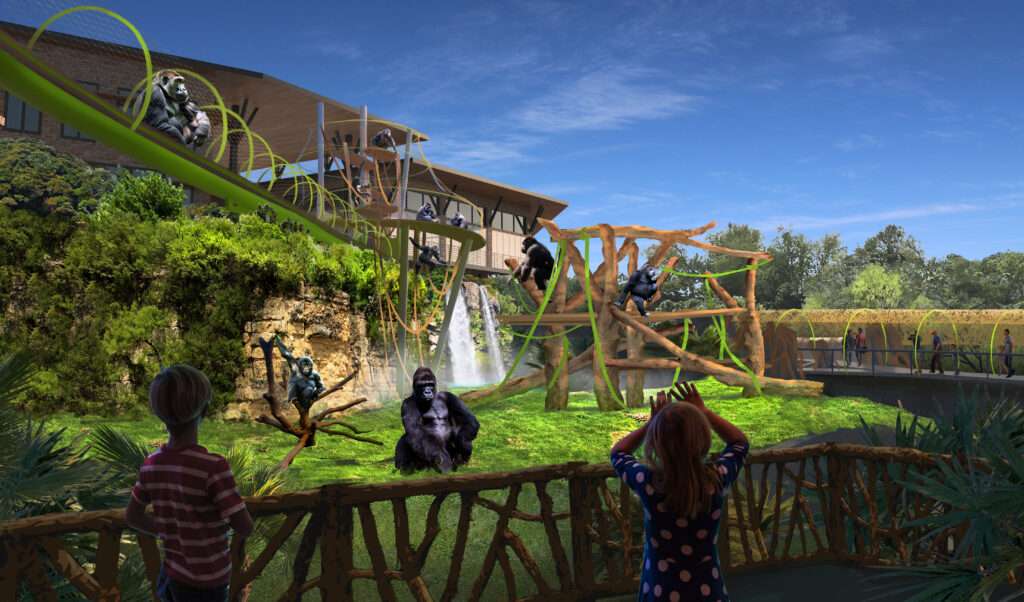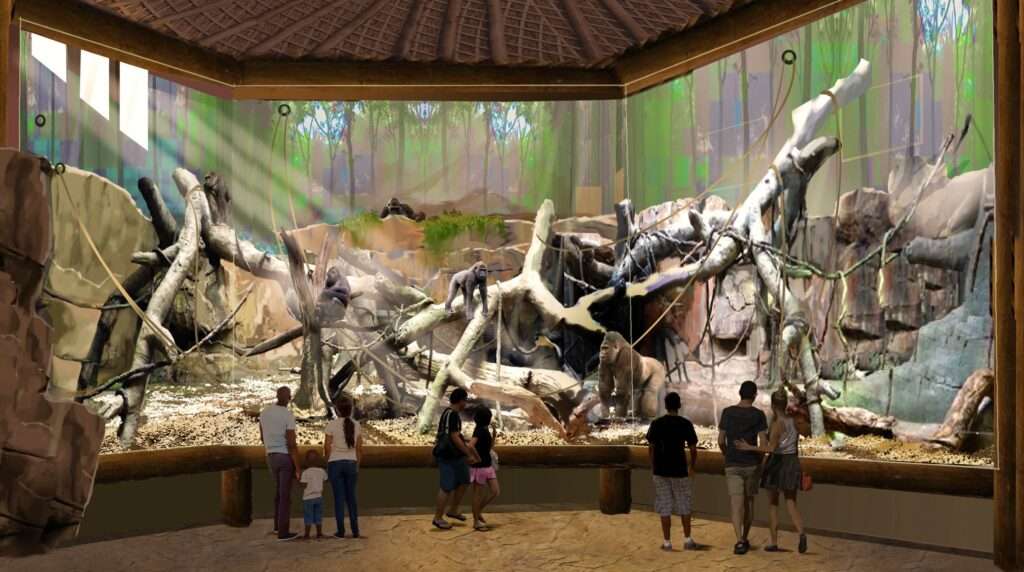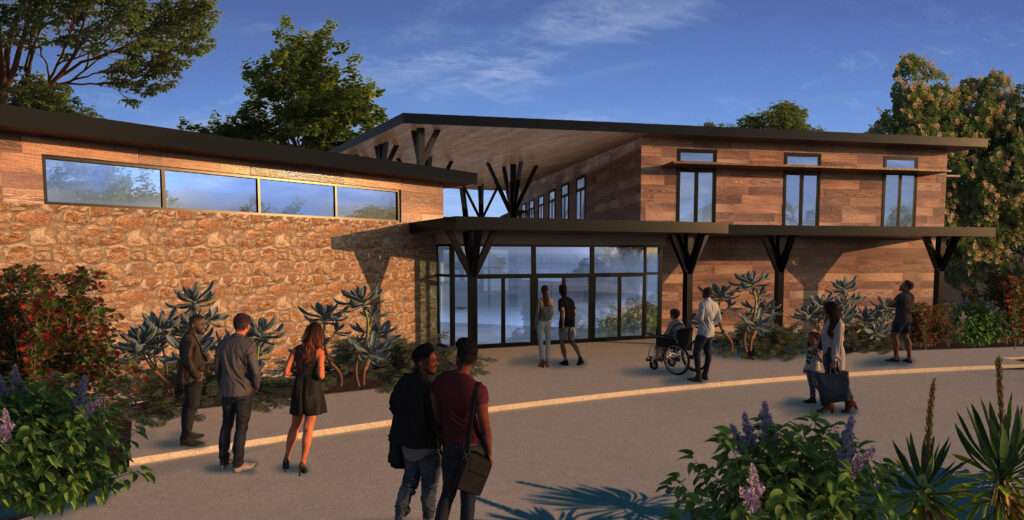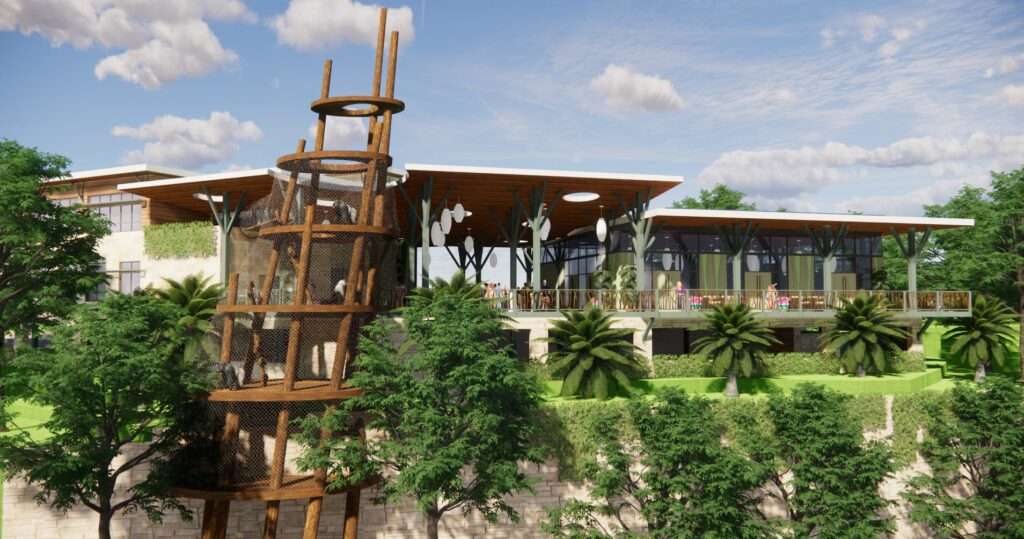Three new projects by PGAV Destinations at San Antonio Zoo pay tribute to the city’s culture and the Zoo’s history
by Joe Kleiman
After investing close to $100 million over the past ten years on new exhibits, San Antonio Zoo is spending an additional $60M on Phase 1 of a long-term master plan, “Generation Zoo,” for which PGAV Destinations is providing architectural and design services.
Phase 1 of the new master plan consists of a newly reimagined entrance plaza (scheduled to open in November 2023) and a gorilla habitat and events center (both to open in 2025). These three projects pay homage to the zoo’s history and its ties with the community of San Antonio, while creating forward- thinking environments in line with today’s best practices in terms of designing for optimal guest experience, animal stewardship and operations.
This is a zoo power pairing. PGAV Destinations is an industry leader in master planning and habitat design for the zoo and aquarium community, including most of the SeaWorld parks – making them an ideal choice to help realize the new vision for the Zoo under the leadership of President and CEO Tim Morrow, who joined from SeaWorld San Antonio in 2014.
Recent projects of PGAV Destinations either completed or in development include the expansion of the Clearwater Marine Aquarium, Expedition Africa, the largest expansion in the history of the Oklahoma City Zoo, and the newly opened SeaWorld Yas Island, Abu Dhabi, which, along with Chimelong Ocean Kingdom and the Georgia Aquarium before it, makes PGAV the record setter for world’s largest multi-species aquariums.
In addition to his current position with San Antonio Zoo, preceded by nearly 20 years with SeaWorld San Antonio, Tim Morrow has served in a number of organizations dedicated to tourism and conservation. Currently, Tim sits on the Executive Board for the International Elephant Foundation as its Past President and on the board for Texas Travel Alliance as Treasurer and Officer. Additionally, he sits on the boards for Visit San Antonio, San Antonio Visitor Alliance, UTSA Alumni Association, Young Presidents Organization’s San Antonio Chapter, Zoo Conservation Outreach Group, San Antonio Chamber of Commerce, San Antonio Sports, International Iguana Foundation, and the Urban Outreach Advisory Committee for the Texas Parks and Wildlife Department.

San Antonio Zoo

PGAV Destinations

PGAV Destinations
He established a longstanding relationship with PGAV Destinations while part of the teams collaborating on such projects as Discovery Cove and the Aquatica animal-based waterparks. When COVID-19 shut down zoos and aquariums throughout the country, under Morrow’s leadership, San Antonio Zoo was one of the first to reopen, introducing the concept of the “drive-thru zoo” where visitors drove through the park in their own vehicles on a route that provided optimal viewing while keeping safe distances between visitors, staff, and animals.
San Antonio Zoo’s origins date back to 1914 and, in 1929, it emerged as an early leader in cageless animal exhibits. Today the 56-acre Zoo, which had an attendance of one million in 2022, houses some 3,500 animals representing more than 800 species. It is considered the top zoo in Texas and one of the best in the US. This AZA-accredited Zoo has been celebrated for its conservation efforts and high standards of animal care.
San Antonio flair
The new entry plaza, the first part of Phase 1, will celebrate the diverse cultures of the community and the architecture of the town’s Hispanic heritage. This turnstile-free entry will streamline and modernize the people flow, eliminating past inconveniences of the old 1950s entrance and complementing – in both aesthetics and operational value – the new parking garage erected in 2021 next to the Will Smith Zoo School. (The five-story, 650-space garage has been described by Morrow as “the most beautiful parking garage on the planet that further amplifies the conservation work we do locally, regionally, and around the world.”)
“The entrance plaza design has a real San Antonio flair, and there’s a lot of art from local artists,” says Tom Marschner, Vice President of PGAV Destinations, who led the master planning for the Zoo. “The Zoo handled the collaboration with the city’s Department of Arts and Culture with those artists and we determined the best locations to place them,” adds Marschner. In addition to sculptures, there will be seven areas where local artists will be able to present paintings, murals, and similar artwork on the exteriors of buildings.
“The theming for the entrance plaza is colorful and bright. It absolutely pops of color,” says Andrew Schumacher, PGAV’s architectural designer on Phase 1. “There are lots of teals and purples, and the buildings are made of natural limestone [both a local building material and a reference to the zoo’s location in a former limestone quarry] and stucco with clay roof tiles.” A retail location at the entrance has been expanded and a new event space has been added. “The entrance itself flanks two buildings,” adds Schumacher, “and the zoo needed additional event space for use after hours, so there’s a stairway or elevator that can be taken up to the roof, and the space is connected by a bridge over the entrance between the two rooftops.”
To better facilitate traffic flow, ticket booths have been eliminated. Admission media are now online or can be purchased via interactive ticketing kiosks. There will also be a concierge desk available to assist guests who have questions regarding their tickets or passes. The new construction for the entrance also consolidates park offices into a single location. Throughout the entrance plaza, colorful banners (papal picado) will fly overhead, similar to the paper banners often found in Mexican marketplaces. Each will feature a latticework animal, bringing a kinetic feeling to the plaza. “The papel picado represents the flavor and feel of San Antonio and the Zoo,” says Morrow.
Mopie and the Monkey House
The focal point of the new entrance plaza will be a celebration of animals and a nod to the zoo’s history, with sculptures of butterflies flying over a giant bronze gorilla sculpture by local artist Bob Guelich. The Zoo is also in discussions with Gillie and Marc Schattner for another gorilla sculpture at the entrance to Congo Falls, the new gorilla habitat (another Schattner sculpture at the zoo is the 17-foot tall “The Last Three,” which pays tribute to the last remaining white rhinos). Both sculptures will pay homage to the zoo’s last gorilla, Mopie and the species’ return. Thirty years ago, Mopie relocated to the Smithsonian’s National Zoo, and until now, San Antonio Zoo has been without gorillas.
Mopie’s former habitat had been at the zoo entrance and is now a lemur habitat with a netted walkway that allows the lemurs to travel overhead, a modern exhibit and enrichment technique that creates visual spectacle for visitors and animals alike while it makes use of all available space. “We try to enrich our animals’ and our guests’ experiences however we can,” says Morrow. “For older zoos, especially those with limited space, we look at building up. How can we expand the habitats that way? We did it with our jaguars. The jaguars have an enclosed pathway that leads through an aviary to the howler monkey habitats. They can see the birds and the monkeys, and the birds and the monkeys can see them. Now the lemurs will be able to see guests and guests can see them in a new way.”
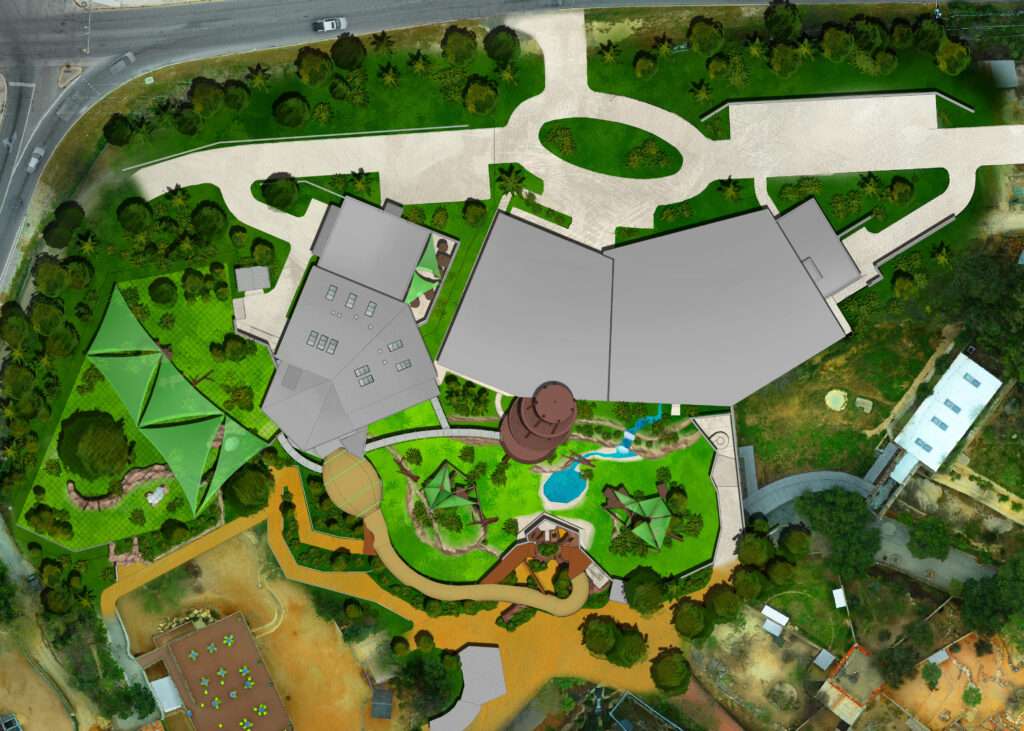
Beginning in 1914 as a wildlife collection in Brackenridge Park, in 1929 San Antonio Zoo unveiled some of the first cageless zoo habitats with the Barless Bear Terraces and Primate Paradise, known by locals as “Monkey Island.” Most monkeys, however, did reside in cages surrounding the Monkey House, a historic stone structure built as a government WPA project during the Great Depression in 1936. Monkeys were removed from the structure a decade ago when the Zoo began redefining its zones on a bio-geographical basis, moving to either South American and African zones, based on the species’ place of origin.
The Monkey House has been repurposed to play a major role in the new entrance plaza. What housed empty cages on one side and storage on the other is being transformed into a central location for guest services, including stroller rental, some retail, a café, and a wraparound bar. The redesign also includes improved comfort facilities. “With the renovation of the Monkey House, we’re adding two large restrooms, two universal changing stations, and a nursing mother’s room,” notes Morrow, (who has two children himself), reflecting the consistent attention to detail and awareness of the needs of families that are essential within the bigger vision.
“We worked closely with the Texas Historical Commission,” says Schumacher, “on what modifications could be done with the Monkey House. We had to restore the windows and clean the stone walls. It’s a protected WPA structure, but now we’re recreating it for a new use.”
Mopie’s legacy
In 2018, San Antonio Zoo approached PGAV Destinations to develop the “Generation Zoo” master plan. “We are 109 years old. The name really represents the generations of families and visitors that have come over time,” explains Morrow, “and their memories coming with their parents, grandparents, children, grandchildren and extended families. It also speaks to the next 100 years of growth, the future generations that will come.” The design studio created four pieces of concept art, each portraying a unique habitat – tropical aviary, country farm, riverfront, and caves. But when guest surveys were completed, one animal always appeared at the top of the list: gorillas.
On the opposite side of the Zoo, currently unused at the base of the stone quarry cliffs, gorillas will soon be returning, to an area called Congo Falls. “We’ve been working on this for two years,” shares Morrow. Mopie was such an integral part of the zoo and a part of the city, and our guests have asked for decades when gorillas would be returning, and Congo Falls was the name of our original gorilla habitat at the entrance. So with our new design, we use the new entrance to set the stage for the zoo, but the gorillas are our anchor attraction. It really is an incredible attraction to show the direction in which the Zoo is moving. San Antonio and St. Louis were the first zoos to present cageless exhibits back in the 1930s. Now we’re taking it to the next level.”
“Similar to the Monkey House,” says Schumacher, “the needs of current design trends outgrew the space.” As part of their research, PGAV Destinations’ design team visited the gorilla habitats at the Houston Zoo and the Omaha Zoo, meeting with zookeepers and discussing the latest AZA standards.
In addition to a veterinary center, indoor housing, and interpretive areas for guests, the area is designed like a trail through a natural habitat, with numerous ways for guests to view and engage with gorillas and vice versa.
“For safety and health reasons, we had to have a separation between gorillas and guests, but still make sure the guests are immersed in the viewing experience. In some areas of the habitat, the experience is up close with only glass separating; in other areas, they’re walking along trails adjacent to the gorillas with separating elements between them. We want to provide as much flexibility as possible in the experience and part of that is incorporating trails. In one area, guests are enclosed in mesh. The design mitigates the risk of guests entering the enclosure.” Within the gorilla habitat, guests will also be able to view the animals above them through a glass ceiling or through bubble windows, which allow them to enter the habitat itself.
As with its other animals, species preservation is of utmost importance – the Zoo is heavily vested in conservation efforts for native Texas and Mexican species, along with a conservation initiative with indigenous peoples of the Amazon, among other national and international projects. As part of those conservation efforts, the Zoo’s new gorillas were selected from other zoos based on genetic variability as per the Association of Zoos & Aquariums’ (AZA) Species Survival Plan.
A window on Africa and San Antonio
High atop the quarry walls will sit the new events center, capable of hosting up to 500 guests for a single event, with the capability to be broken down into smaller enclosed spaces. The space is being funded completely by private donations. “We are using lots of natural materials, lots of woods,” says Schumacher. The color scheme is neutral, so it makes it easy to provide flexibility in the space for any kind of event. The pillars mimic trees; there’s a grassy, naturalistic pattern to it, with little silhouettes of animals as well.”
The use of a design scheme for the event facility incorporating natural and animal motifs is fitting, considering its juxtaposition with the Zoo habitats below. Because of the placement of habitats on the embankment that leads up to the foot of the quarry cliff, through a giant viewing window, event center attendees will see gorillas and lions in the foreground, with the Zoo’s African savannah, including its rhinos and hippos, beyond, and in the distance, the skyline of downtown San Antonio. Divided into two buildings, the central outdoor plaza of the events center will be highlighted by a distinct feature unique to the park – Silverback Peak [working title]. This six-story climbing tower rises from the gorilla habitat below and events center guests will be able to come eye-to-eye with members of the Zoo’s gorilla troop at the top, separated only by a layer of glass.
Elephants ahead
The park for many years was home to Lucky, an older lone Asian elephant. Morrow worked out a deal with Feld Entertainment for two retired female elephants from the Ringling Bros. Circus to join Lucky. The endeavor succeeded and the three lived together for a number of years, known collectively as “The Golden Girls.” With the passing of Lucky and one of the Ringling elephants, the decision was made to send the remaining Golden Girl to an elephant sanctuary.
“But the elephants are returning,” says Morrow. “Our next phase is going to involve returning Asian elephants to the Zoo.” Undeveloped zoo property on the other side of the freeway, behind the parking garage and the Zoo School will become the Zoo’s Asian district, with the elephants being the main draw.
“We have a lot we want to develop,” says Morrow. “Our Zoo School has a waiting list of 8,000 potential students. We have an opportunity to expand that, maybe even statewide or on a national level. We’re determining what that can look like, if it’s a private or public endeavor, and what types of partners, like universities, we might want to bring onboard.” Also in the works is a safari park. Morrow recently visited zoos in St. Louis and Omaha to see firsthand their concepts for a second, more open campus.
“But first, we finish and open Phase 1,” Morrow shares, “with the entrance plaza, events center, and gorillas. Then we’ll be in a good spot to approach our donors for the next phases of our evolution.” •


